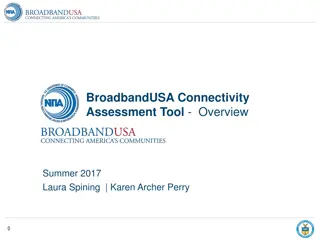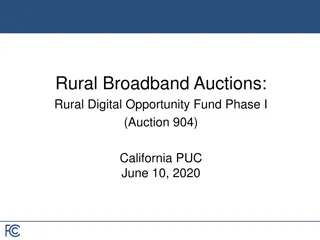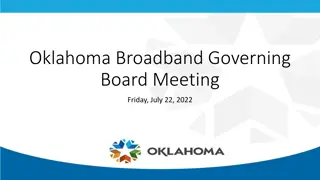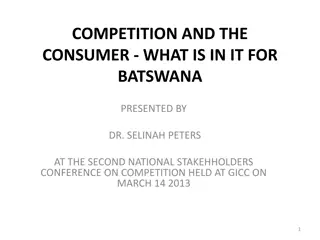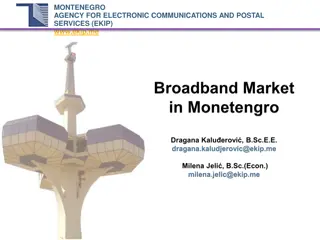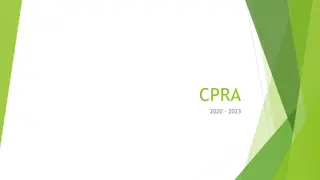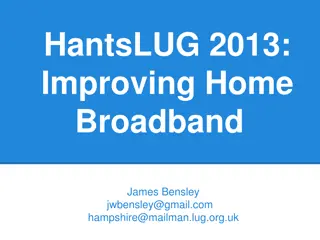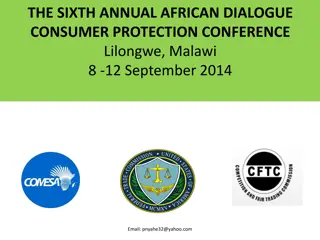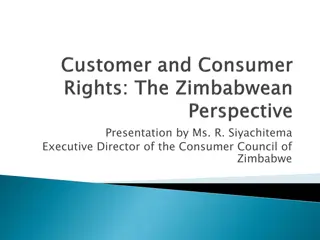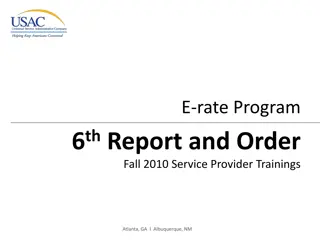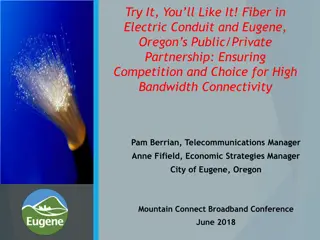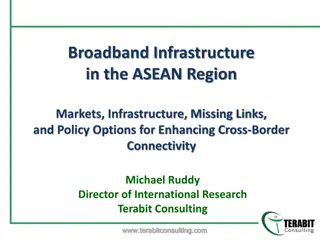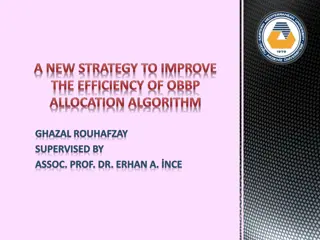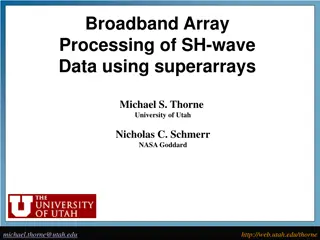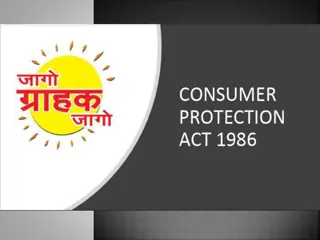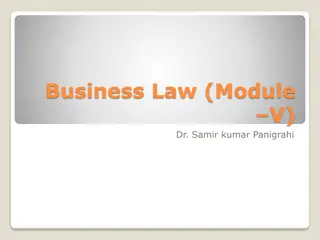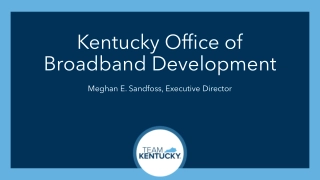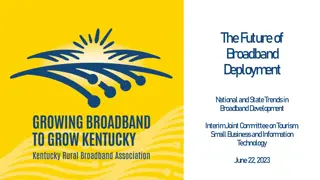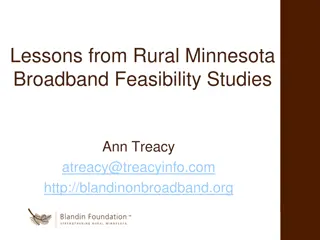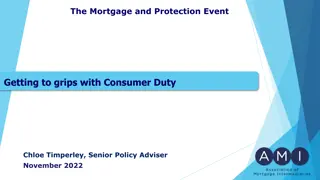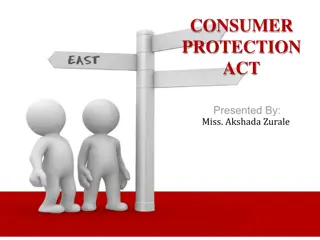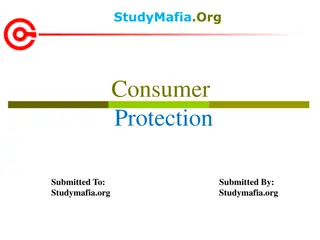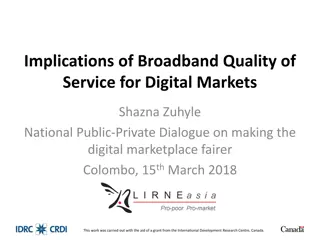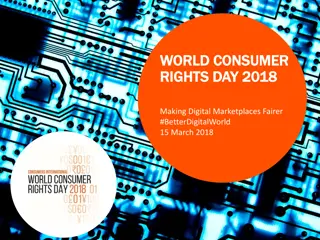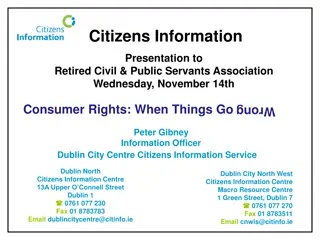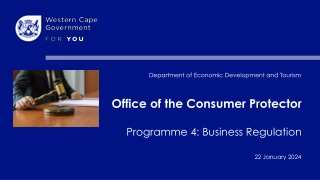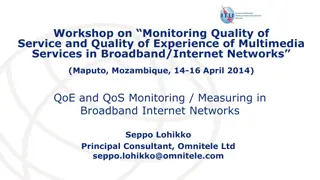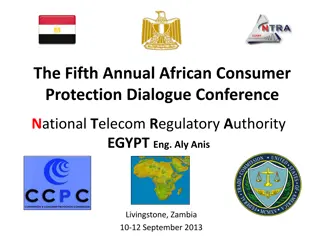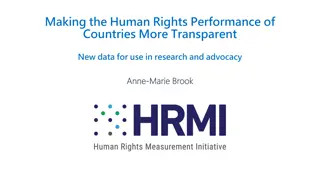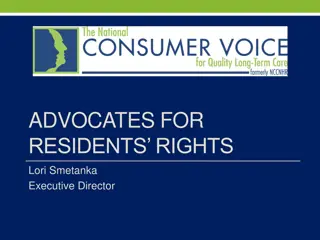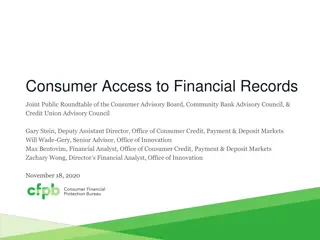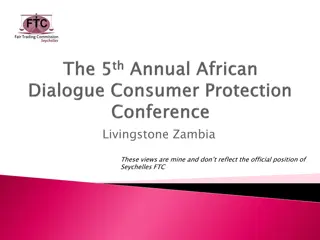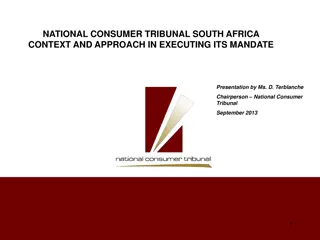Consumer Rights and Quality of Broadband Services in India
This document discusses the status of institutional and legal mechanisms in India concerning consumer rights and access to broadband services. It highlights the importance of the Draft National Telecom Policy 2011 in ensuring affordable, reliable, and secure telecommunication and broadband services across the country. The rights of consumers, including protection from hazardous goods and services, information transparency, choice, redressal, and education, are emphasized. Quality of service parameters such as activation time, bandwidth utilization, and customer perception are also outlined.
Uploaded on Oct 07, 2024 | 0 Views
Download Presentation

Please find below an Image/Link to download the presentation.
The content on the website is provided AS IS for your information and personal use only. It may not be sold, licensed, or shared on other websites without obtaining consent from the author. Download presentation by click this link. If you encounter any issues during the download, it is possible that the publisher has removed the file from their server.
E N D
Presentation Transcript
`Quality of service and access to broadband services in India` Hemant Upadhyay Advisor Telecom & IT
VOICE Voluntary Organization in Interest of Consumer Education Consumer rights vis- -vis quality of service and access to broadband services: Status of institutional and legal mechanism available in India HU/cuts 2 VOICE 09/12/13
CONSUMER AGENDA The Draft National telecom Policy 2011 released on 10.10.2011 states that The primary objective of NTP-2011 is maximizing public good by making available affordable, reliable and secure telecommunication and broadband services across the entire country. . Pursuant to NTP-2011, these principles would guide decisions needed to strike a balance between the interests of users/ consumers, service providers and government HU/CUTS revenue. 3 VOICE 09/12/13
INDEX BROADBAND SERVICE CONSUMER RIGHTS QUALITY OF SERVICE ROLE OF TRAI INSTITUTIONAL & LEGAL MECHANISM HU/CUTS 4 VOICE 09/12/13
BROADBAND SERVICE Broadband per Broadband Policy 2004 -- An always on data connection that is able to support interactive services including Internet access has the capability of the minimum download speed of 256 kilo bits per second (kbps) to an individual subscriber from the Point of Presence (POP) of the service provider HU/CUTS 5 VOICE 09/12/13
CONSUMER RIGHTS The right to be protected from all kind of hazardous goods and services The right to be fully informed about the performance and quality of all goods and services The right to free choice of goods and services The right to be heard in all decision-making processes related to consumer interests The right to seek redressal, whenever consumer rights have been infringed The right to complete consumer education HU/CUTS 6 VOICE 09/12/13
QUALITY OF SERVICE Activation Time Fault Repair / Restoration Time Billing Performance Response time to the customer for assistance Bandwidth Utilization/Throughput Service Availability / Uptime Packet Loss Network Latency Customer perception of Services HU/CUTS 7 VOICE 09/12/13
ROLE OF TRAI Regulation Performance Monitoring Consumer education Consumer protection Just growth of broadband market HU/CUTS 8 VOICE 09/12/13
INSTITUTIONAL & LEGAL MECHANISM National broadband plans are an important mechanism for governments to set this vision and strategy of how technology can move their own country forward. HU/CUTS 9 VOICE 09/12/13
INSTITUTIONAL & LEGAL MECHANISM Among ICTs, broadband adoption has demonstrated the greatest impact on GDP growth and the use of broadband at the individual level has changed our lives in a myriad of ways. HU/CUTS 10 VOICE 09/12/13
INSTITUTIONAL & LEGAL MECHANISM The full benefits of broadband for enhancing national competitiveness and empowering citizens are realized where there is strong partnership between government, industry and other stakeholders where governments engage in a consultative, participatory approach to the policy-making process, in conjunction with stakeholders. HU/CUTS 11 VOICE 09/12/13
CONSUMER AGENDA The Draft National telecom Policy 2011 released on 10.10.2011 states that The primary objective of NTP-2011 is maximizing public good by making available affordable, reliable and secure telecommunication and broadband services across the entire country. .Pursuant to NTP-2011, these principles would guide decisions needed to strike a balance between the interests of users/ consumers, service providers and government revenue. HU/CUTS 12 VOICE 09/12/13
CONSUMER AGENDA STRATEGY To develop an eco-system for broadband in close coordination with stakeholder To recognize Right to Broadband Emphasis on providing reliable and affordable broadband To revise the existing broadband download speed of 256 Kbps to 512 Kbps and subsequently to 2 Mbps by 2015 and higher speeds of at least 100 Mbps thereafter HU/CUTS 13 VOICE 09/12/13
CONSUMER AGENDA THE GROUND REALITY AS ON DATE Only 13.3 mn. broadband subscribers against 893 mn. Mobiles as on 31.12.2011. The target envisaged for broadband to achieve 175 million broadband connections by the year 2017 and 600 million by the year 2020 at minimum 2 Mbps download speed is nowhere in sight. Only download speed is considered as specification for broadband Broadband is defined with a min speed of 256 Kbps. There are almost no countries left now who consider such low speed as broadband.(See annex. I) No other parameters (like Upload Speed, PING, Jitter, SNR Margin, Line Attenuation, Availability (24x7), Fluctuation within a 24 hour period etc.) are there defining broadband officially. Quality of Service (QOS) has no meaning without strict defining parameters. Without defining parameters, benchmarking is not possible either. Relative tariffs in India in relation to the quality are high compared to other countries. Wireline ISPs like MTNL, VSNL, Airtel and Reliance have infrastructure but do not seem to be going all out to add subscribers. On the other hand there are ISPs who want to expand, do not have the infrastructure or the capacity to invest in infrastructure. HU/CUTS 14 VOICE 09/12/13
CONSUMER AGENDA Create a robust definition of BROADBAND. Establish criteria for defining broadband like Upload Speed, PING, Jitter, SNR Margin, Line Attenuation, Availability (24x7), Fluctuation within a 24 hour period etc. in line with international practices. Change criteria for Broadband using basic floor parameters compatible with international standards like a minimum speed of say 1 Mbps etc. The ISPs should be made to provide tools to consumers to monitor the parameters on their own to ensure that promised services are delivered to them. Tariffs are required to be regulated in line with internationally operating tariffs. The criteria for tariff fixation should be- Prevailing tariffs in major developed as well as comparable developing countries. Prevailing voice/broadband tariff ratios for major countries. HU/CUTS Primary aim to grow the broadband subscriber base. 15 VOICE 09/12/13
CONSUMER AGENDA Quality of Service (QoS)- 1.Clearly defined and documented specifications for broadband services by ISPs 2.Identify the performance standards and QoS parameters benchmarked against the best international standards 3.Evolve suitable compliance mechanism 4.Improve transparency in providing information by ISPs to consumers and TRAI 5.NTP -2011 recognises the need for formulating a separate Code of Practice for Sales and Marketing. 6.Clearly defined penalties PAYABLE to CONSUMERS for each deficiency in service. 7.Make provision for independent testing agency for dispute resolution specially w.r.t. download/upload speed etc. 8.Broadband connection is very critical even for an individual consumer s day to day functioning. Hence dispute resolution time lines should be shortened to 1 to days at the most at each stage. Undertake legislative measures to bring disputes between telecom consumers HU/CUTS and service providers within the jurisdiction of Consumer Forums/ Consumer Protection Act. 16 VOICE 09/12/13
CONSUMER AGENDA To Stimulate demand for broadband- 1.Provide high speed and high quality broadband access to all village panchayats through optical fibre by the year 2014 and progressively to all villages and habitations. 2.Work closely with Department of IT in the promotion of content creation particularly in vernacular languages 3.Utilise UNIVERSAL SERVICE OBLIGATION FUND (USOF) in improving last mile connectivity 4.Incorporate enabling provisions in the current regulatory framework so that existing infrastructure including cable TV networks are optimally utilised for extending high quality broadband services in rural areas also. 5.Fully support the sector regulator in their efforts to enhance consumer awareness about services, tariffs, and QoS. 6.Dissociate carrier and service providers (both need not be same) to utilize physical assets of BSNL/MTNL Promote wireless for faster dispersal of broadband but regulate QOS and tariffs HU/CUTS 17 VOICE 09/12/13
CONSUMER AGENDA Regulatory framework 1.Regulations defining Network Service Operator (NSO)/ Communication Network Service Operator (CNSO) and Service Delivery Operator (SDO)/ Communication Service Delivery Operator (CSDO) and licensing for the same 2.Undertake a comprehensive review of Indian Telegraph Act and its rules and other allied legislations with a view to making them consistent with and in furtherance of the broadband. 3.Undertake legislative measures to bring disputes between telecom consumers and service providers within the jurisdiction of Consumer Forums/ Consumer Protection Act. HU/CUTS 18 VOICE 09/12/13


